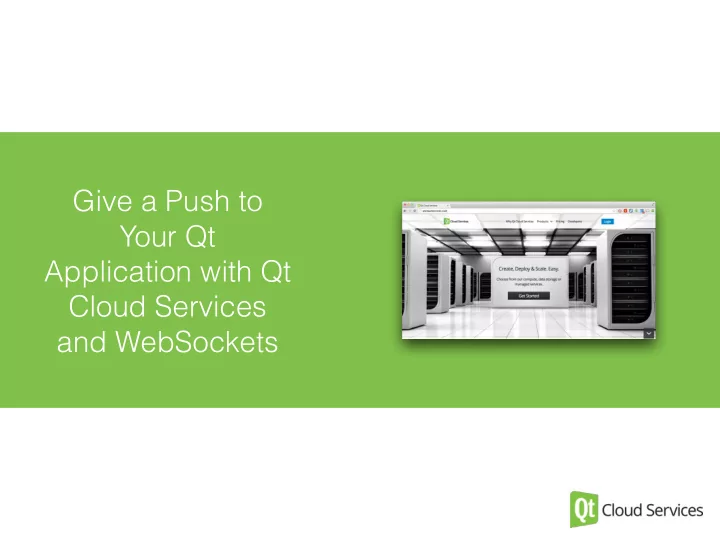

Give a Push to Your Qt Application with Qt Cloud Services and WebSockets
About me
Lauri Nevala nevalau nevalla nevalla • Working in Qt Cloud Services team at The Qt Company • Over ten years of experience in creating web and mobile based applications
Our Goal Understand how to use Qt Cloud Services in order to send and receive WebSocket messages
What is Qt Cloud Services Enginio ¡Data ¡Storage ¡ Storage ¡for ¡Applica/on ¡Data ¡ Use ¡with ¡QtEnginio ¡Library Managed ¡Applica3on ¡Run3me ¡ Applica/on ¡Pla<orm ¡as ¡a ¡Service ¡ Support ¡for ¡Qt/C++, ¡NodeJS, ¡Apache, ¡PHP, ¡MongoDB, ¡MySQL, ¡Redis… ¡ Managed ¡WebSocket ¡ Real-‑Time ¡Socket ¡Connec/ons ¡with ¡virtually ¡unlimited ¡scalability ¡ Use ¡with ¡SDK’s ¡and ¡Qt ¡WebSocket ¡Client ¡Library ¡
Enginio Data Storage (EDS) Flexible and powerful cloud data storage with built-in user and data access control
Managed Application Runtime (MAR) Scalable, � Multi-language, � Multi-database, � Application Platform as a Service
Managed Application Runtimes How does it work?
Supported Frameworks Supported frameworks by 3rd party build packs Scala, Clojure, Play, Gradle, Grails, PHP, Go, Meteorite, Perl, Dart, Nginx, Apache, Jekyll
Built-in Services or choose from our cloud based services Enginio Data Storage � Managed WebSocket or choose anything with SDK ... Amazon, Azure, Google ...
Developer Friendly Deployment Deploy using Git – the most common VCS among developers > ¡git ¡push ¡qtc ¡master
Mana ged WebSocket (MWS) Fully managed service implementing a bi-directional, real- time communication gateway for WebSockets.
Managed WebSocket How does it work?
1. get WebSocket URI 3. send WebSocket message 4. deliver WebSocket message 2. open WebSocket connection { ¡data: ¡'{ ¡ ¡ ¡ ¡ ¡"object":{ ¡ ¡ ¡ ¡ ¡ ¡ ¡ ¡"id":"541df1c1e5bde554a805b213", ¡ ¡ ¡ ¡ ¡ ¡ ¡ ¡"createdAt":"2014-‑09 ¡20T21:29:37.849Z", ¡ ¡ ¡ ¡ ¡ ¡ ¡ ¡"device":"FZXC0wg0LvaJ", ¡ ¡ ¡ ¡ ¡ ¡ ¡ ¡"done":false, ¡ ¡ ¡ ¡ ¡ ¡ ¡ ¡"objectType":"objects.todos", ¡ ¡ ¡ ¡ ¡ ¡ ¡ ¡"text":"testi2", ¡ ¡ ¡ ¡ ¡ ¡ ¡ ¡"updatedAt":"2014-‑09-‑20T21:29:37.849Z", ¡ ¡ ¡ ¡ ¡ ¡ ¡ ¡"userId":"user:54196f3f5a3d8b61860381a4" ¡ ¡ ¡ ¡ ¡}, ¡ ¡ ¡ ¡ ¡"meta":{ ¡ ¡ ¡ ¡ ¡ ¡ ¡ ¡ ¡"backendId":"5417e5485a3d8b418a01adb7", ¡ ¡ ¡ ¡ ¡ ¡ ¡ ¡ ¡"eventName":"create", ¡ ¡ ¡ ¡ ¡ ¡ ¡ ¡ ¡"requestId":"a671f67b4f41c20b53988a6057b32539", ¡ ¡ ¡ ¡ ¡ ¡ ¡ ¡ ¡"userId":null} ¡ ¡ ¡ ¡ ¡}', ¡ ¡ ¡ ¡ ¡receivers: ¡{ ¡ ¡ ¡ ¡ ¡ ¡ ¡ ¡ ¡ ¡sockets: ¡['*'], ¡ ¡ ¡ ¡ ¡ ¡ ¡ ¡ ¡ ¡tags: ¡[] ¡ ¡ ¡ ¡ ¡ ¡} ¡ ¡ }
WebSockets Consider using WebSockets for instantaneous data without the browser refresh
Where to use? • Chats • Social feeds • Multiplayer games • Collaborative editing • Sport updates • Location based apps • Your killer app
Why WebSockets are so great? • WebSockets defines an API establishing “socket” connections between web clients and a server • TCP-based protocol • Full-duplex, simultaneous bi-directional messaging • Uri scheme ws: and wss:
WebSockets and Qt Cloud Services 1. + ➡ public socket 2. + + ➡ private socket 3. ➡ do anything you want
https://flic.kr/p/dUtbk5 Public sockets
+
WebSocket server Create EDS instance Create MWS instance Create EDS Webhook
WebSocket server Create EDS instance Create MWS instance Create EDS Webhook
WebSocket server Create EDS instance Create MWS instance Create EDS Webhook
Create EDS Webhook http://bit.ly/eds-mws-webhook
EDS MWS App HTTP POST https://mws-eu-1.qtc.io/v1/gateways/MWS_GATEWAY_ID/webhook_receivers/enginio { ¡data: ¡'{ ¡ send WebSocket message to all sockets ¡ ¡ ¡ ¡"object":{ ¡ ¡ ¡ ¡ ¡ ¡ ¡ ¡"id":"541df1c1e5bde554a805b213", ¡ ¡ ¡ ¡ ¡ ¡ ¡ ¡"createdAt":"2014-‑09 ¡20T21:29:37.849Z", ¡ { ¡ ¡ ¡ ¡ ¡ ¡ ¡ ¡"device":"FZXC0wg0LvaJ", ¡ ¡ ¡ ¡ ¡"object":{ ¡ ¡ ¡ ¡ ¡ ¡ ¡ ¡"done":false, ¡ ¡ ¡ ¡ ¡ ¡ ¡ ¡"id":"541df1c1e5bde554a805b213", ¡ ¡ ¡ ¡ ¡ ¡ ¡ ¡"objectType":"objects.todos", ¡ ¡ ¡ ¡ ¡ ¡ ¡ ¡"createdAt":"2014-‑09 ¡20T21:29:37.849Z", ¡ ¡ ¡ ¡ ¡ ¡ ¡ ¡"text":"testi2", ¡ ¡ ¡ ¡ ¡ ¡ ¡ ¡"device":"FZXC0wg0LvaJ", ¡ ¡ ¡ ¡ ¡ ¡ ¡ ¡"updatedAt":"2014-‑09-‑20T21:29:37.849Z", ¡ ¡ ¡ ¡ ¡ ¡ ¡ ¡"done":false, ¡ ¡ ¡ ¡ ¡ ¡ ¡ ¡"userId":"user:54196f3f5a3d8b61860381a4" ¡ ¡ ¡ ¡ ¡ ¡ ¡ ¡"objectType":"objects.todos", ¡ ¡ ¡ ¡ ¡}, ¡ ¡ ¡ ¡ ¡ ¡ ¡ ¡"text":"testi2", ¡ ¡ ¡ ¡ ¡"meta":{ ¡ ¡ ¡ ¡ ¡ ¡ ¡ ¡"updatedAt":"2014-‑09-‑20T21:29:37.849Z", ¡ ¡ ¡ ¡ ¡ ¡ ¡ ¡ ¡"backendId":"5417e5485a3d8b418a01adb7", ¡ ¡ ¡ ¡ ¡ ¡ ¡ ¡"userId":"user:54196f3f5a3d8b61860381a4" ¡ ¡ ¡ ¡ ¡ ¡ ¡ ¡ ¡"eventName":"create", ¡ ¡ ¡ ¡ ¡}, ¡ ¡ ¡ ¡ ¡ ¡ ¡ ¡ ¡"requestId":"a671f67b4f41c20b53988a6057b32539", ¡ ¡ ¡ ¡ ¡"meta":{ ¡ ¡ ¡ ¡ ¡ ¡ ¡ ¡ ¡"userId":null} ¡ ¡ ¡ ¡ ¡ ¡ ¡ ¡ ¡"backendId":"5417e5485a3d8b418a01adb7", ¡ ¡ ¡ ¡ ¡}', ¡ ¡ ¡ ¡ ¡ ¡ ¡ ¡ ¡"eventName":"create", ¡ ¡ ¡ ¡ ¡receivers: ¡{ ¡ ¡ ¡ ¡ ¡ ¡ ¡ ¡ ¡ ¡"requestId":"a671f67b4f41c20b53988a6057b32539", ¡ ¡ ¡ ¡ ¡ ¡ ¡ ¡ ¡sockets: ¡['*'], ¡ ¡ ¡ ¡ ¡ ¡ ¡ ¡ ¡ ¡"userId":null} ¡ ¡ ¡ ¡ ¡ ¡ ¡ ¡ ¡tags: ¡[] ¡ ¡ ¡ ¡ ¡ ¡} ¡ ¡ ¡ ¡ ¡} ¡ ¡ } }
WebSocket server Create a EDS instance Create a MWS instance Create EDS Webhook
Enginio Todo http://bit.ly/qtc-todo
2. create Todo 1. connect to WebSocket 3. trigger Webhook 5. refresh UI 4. send WebSocket message
websocketclient.cpp #include ¡"websocketclient.h" ¡ #include ¡<QtCore/QDebug> ¡ � QT_USE_NAMESPACE ¡ � WebSocketClient::WebSocketClient(const ¡QUrl ¡&url, ¡QObject ¡*parent) ¡: ¡ ¡ ¡ ¡ ¡QObject(parent), ¡ ¡ ¡ ¡ ¡m_url(url) ¡ { ¡ ¡ ¡ ¡ ¡connect(&m_webSocket, ¡&QWebSocket::connected, ¡this, ¡&WebSocketClient::onConnected); ¡ ¡ ¡ ¡ ¡connect(&m_webSocket, ¡&QWebSocket::disconnected, ¡this, ¡&WebSocketClient::closed); ¡ ¡ ¡ ¡ ¡m_webSocket.open(QUrl(url)); ¡ } ¡ � void ¡WebSocketClient::onConnected() ¡ { ¡ ¡ ¡ ¡ ¡qDebug() ¡<< ¡"WebSocket ¡connected"; ¡ ¡ ¡ ¡ ¡connect(&m_webSocket, ¡&QWebSocket::textMessageReceived, ¡ ¡ ¡ ¡ ¡ ¡ ¡ ¡ ¡ ¡ ¡ ¡ ¡this, ¡&WebSocketClient::onTextMessageReceived); ¡ } ¡ � void ¡WebSocketClient::onTextMessageReceived(QString ¡message) ¡ { ¡ ¡ ¡ ¡ ¡emit ¡onMessageReceived(message); ¡ }
Recommend
More recommend